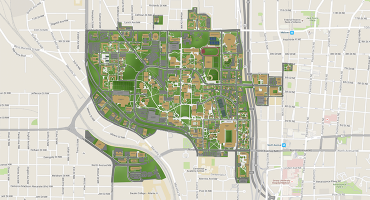School of Mathematics Professor Anton Leykin has been awarded a prestigious Simons Fellowship for his proposal of applying nonlinear algebra to tackle one of the key mathematical questions of the 21st century. Leykin is one of two mathematicians in the School awarded the Fellowship, and is joined by Associate Professor Benjamin Jaye.
The work could lead to new discoveries and a deeper understanding of how celestial bodies like planets, moons, and asteroids interact. The fellowship will fund one year of work, during which Leykin also plans to finish writing a book on nonlinear algebra for advanced undergraduate and beginning graduate students.
Leykin explains that the mathematical problem — known as “Smale's sixth problem” for its position as number six on the list of questions for the 21st century compiled by Fields Medalist Stephen Smale — involves understanding the number of ways celestial bodies can be arranged in space so that they stay at relative equilibrium, growing neither further apart nor closer to each other as they orbit.
“People have been trying to solve this problem for more than two hundred years — since Euler and Lagrange — but even proving that the number of relative equilibria in an n-body problem is finite is extremely difficult,” Leykin says. One reason for this? “Even for small cases, (e.g. n=5) the brute-force approach leads to an enormous amount of computation.”
Each of Leykin’s initial experiments for the case n=6 required a CPU year — the computational power equivalent to a single computer running for an entire year.
This difficulty is partially what draws Leykin to the problem. “We use supercomputers to help with the computation time, but this isn’t an area that AI and machine learning can advance,” he explains. “For this type of problem, we need human intelligence — and even with our current technology, there are no easy solutions. It’s a challenge, but that is what makes it interesting.”
Stellar pathways
Imagine the Moon and Earth as two celestial bodies on a plane. Both exert gravitational force on each other — we can see the result as tides on Earth and the Moon’s orbit. Now add the Sun and other planetary bodies to the plane: asteroids, satellites, and other planets. These bodies also exert gravitational force — a function of their masses and distances apart — creating a complex system of orbits and trajectories.
Smale’s sixth problem imagines a plane like this, with any number of celestial bodies arranged on it. The problem considers an arrangement of the bodies in a way that the gravitational forces balance, so that even while they are interacting and orbiting, none of the bodies travel further away or closer to each other.
“It has been conjectured, but so far not shown, that the number of such configurations is finite,” Leykin says. “It seems simple. Is it finite or infinite? But progress is minimal at the moment. Several approaches settle the question for almost all values of n=5 masses with the case n=6 wide open, even for a non-special choice of masses.”
Leykin is taking a different approach than many researchers, leveraging a field of mathematics called tropical geometry, which simplifies the geometry of curved equations as straight lines.
“We're not trying to compute or describe the original solution manifold but rather replace it with its tropicalization, a combinatorial shadow which captures the finiteness aspect,” he explains.
Leykin’s method has already found success for the case n=5. “A recent paper proved that for five bodies, if the masses are general enough, there are a finite number of relative equilibria,” Leykin shares. “Using our approach, we were able to reproduce the result for five celestial bodies in a simpler way.”
“Our goal now is to collect more evidence by solving the problem for six bodies,” he adds. “If this helps lead us to a general solution to the problem as a whole — that would be great.”
Space ‘storage spots’
While the project is theoretical, it could lead to a greater understanding of celestial mechanics.
Leykin is collaborating on a separate but related project with aerospace departments around the country. “We're working to understand the trajectories of a massless spacecraft, assuming it is primarily affected by gravitation of the Moon and the Earth,” he shares.
The 18th century mathematics developed for this type of problem, a restricted three-body problem, could help teams use the gravitational pull of the Earth and Moon to place a small spacecraft near a Lagrangian point — a space “storage spot” where it would remain stationary relative to the Earth.
“You can place something at a Lagrangian point, and it will stay stationary relative to the system,” Leykin explains. “It's a way to place things so they don't move.” For example, in the Sun-Earth system, the James Webb Space Telescope was placed at one of these points, where it conveniently stays in Earth’s shadow — avoiding the bright light and heat of the Sun, Earth, and Moon.
“Smale’s sixth problem is about acquiring more theoretical knowledge,” Leykin adds. “If we discover something on the theoretical front, it can be of practical importance for applied scientists and designing missions for exploratory spacecraft going far into the solar system.”



